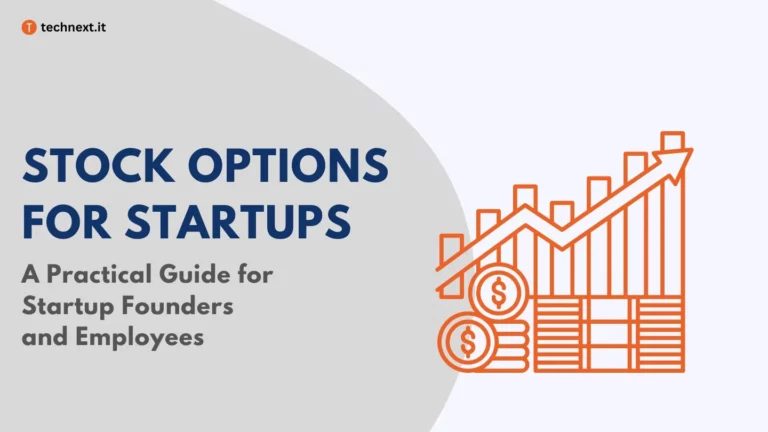How to do Market Research for Startups (Complete Guide)
How do you know that your startup idea is valid? Yes, through market research, but what is the right way to conduct market research for your startup? Let’s discuss.

There is a famous saying, “Look before you leap,” If you are thinking of starting a startup, this saying is a must to follow.
Too often, startup founders rely on their intuition and past experience to determine what products and services to offer consumers. While this can be a successful approach for some startups, it’s important to remember that the tech industry is constantly evolving, so it’s critical to validate your idea first. The most effective approach is through market research. This article will give you a complete overview of market research for tech startups.
In this article, we will provide you with a complete guide on how to do market research for startups.
Fundamentals of Market Research
In order to get started with startup market research, it’s helpful to know the fundamentals of the field.
What Is Market Research?
Market research is a process that helps organizations understand the needs and wants of their customers. Through market research, businesses can learn about their target consumers, what they’re interested in, and how best to reach them. Market research can be conducted through surveys, focus groups, interviews, and other methods. The results of market research can help businesses make informed decisions about their products and services, marketing campaigns, and more.
Importance Of Market Research for Tech Startups
Take a look at the reasons why market research for startups is essential:

Provides an accurate representation of market demand
The first thing you want to know is whether the product you are trying to develop actually has demand. Market research will give you a true picture of the market’s needs by collecting detailed information on the present market landscape, which can minimize your business risk.
Assists in determining product price and future profit.
Market research can also assist you in determining a pricing strategy by determining how much your customers are willing to spend on your product. Plus how much profit you can expect in the long run.
Ensures investor funding:
One of the most critical things to do when starting a business is to attract investors. A well-done startup market research can show investors your product has business potential. The market research outcome also provides you with the data you need to convince your potential investors.
Reveals customer’s expectations
Reviews from your targeted customers can help you to improve your product. And also, you can find out which features matter most to potential customers.
Provides a competitor analysis
A new business can do better when it can offer better solutions than the competitors. Market research identifies the gap by analyzing your competitors, thus keeping you ahead of your competitors.
Makes decision-making easier
In a business, there is no alternative to making informed decisions. Especially when you are starting a tech startup. Data-driven market research for startups can help you with decision-making by giving different aspects about the market demand, customers’ expectations, etc.
Now that you are familiar with the importance of market research, you might wonder when is the right time to do one.
When is the right time to do market research for a startup?
The answer to this question will vary depending on who you ask and what they need from your study, but there are some general guidelines. For example, in the case of start-ups, you should conduct market research before launching a new product. Startup market research involves information about the target market, location, customer behavior, dynamics, and other factors thoroughly, which can help you set up your new business. You can also conduct multiple research if you need to at any phase of your startup.
What Is The Main Focus Of Market Research For A Startup?
For a startup, the main focus of market research should be understanding the needs and wants of its target market. This includes understanding their demographics, such as age, gender, location, and income.
Additionally, it’s important to understand their psychographics, such as lifestyle, values, and interests. Additionally, market research for a startup should also include an analysis of the competition. This will help to identify any gaps in the market that the startup can fill. By understanding the needs and wants of their target market and analyzing the competition, a startup can develop a clear marketing strategy that will help them to succeed.
How Much Does It Cost To Do Market Research?
There is no fixed cost when it comes to market research. The cost of market research varies depending on the size and scope of the project. Normally you should plan to spend about $20,000 to $50,000 for an acceptable custom market research project.
The cost also depends on the methods used to collect data. Generally, surveys and focus groups are the most expensive methods, while data from secondary sources is relatively inexpensive.
In addition, the cost of market research varies depending on the experience of the researcher. An experienced researcher with access to high-quality data sources can often complete a project for less than a novice researcher who has to rely on primary data collection. As a result, the cost of market research can vary significantly depending on the needs of the client.
In case you don’t have enough resources to conduct full-scale market research, you can go for mini-market research to access the potentiality of your startup. That is going to cost you $2,000 to $6,000.
After knowing the fundamentals, if you are willing to conduct market research for your startup, here is ‘How to Conduct Market Research for a Startup to Validate Your Idea” explained to support you stay on top of your game.
How to Do Market Research for a Startup to Validate Your Idea
Carrying out well-defined market studies is not easy. To make it easy to understand, we made a 5-step guide on how to do market research for a startup to validate your idea. Let us begin.

Define The Big Picture: Outline Possibilities Or Problems.
When you want to perform market research, first determine what you hope to learn from the research. Describe the idea or problem you want to solve, and then you will get the information you require and how you can obtain it. To identify the information, you can prepare some questions, or, in other words, you can form a hypothesis. These specific questions will help you identify the most pressing demands or the best opportunity to achieve your research goals. For example:
- What’s my user’s biggest pain point?
- Does my product meet your needs?
- What is my target user’s first thought about the product?
- Would they buy this product if it were available right now?
- How much will they pay?
Try making questions that will help you look into all possible causes and figure out what you really need to know to solve the problem or decide what to do with the opportunity.
Pick a Suitable Strategy That Meets Your Needs.
Pick a suitable strategy that lends legitimacy to the research and scientifically sound results. In addition, it gives a clear plan that assists researchers in staying on track, making the process efficient, productive, and manageable. Here is a breakdown of the main types of market research.
Primary research
Primary research is the collection of data firsthand which means research is performed directly by your startup or hired resource who will conduct the research.
When to perform primary research
When you want to know your customers’ willingness to pay for your product, how they view your startup, or what they think about future quality improvement. And also, to identify your competitors.
How to collect the data
Usually, you go directly to the source or marketplace and ask questions to find the information you need. Most startup founders use survey data, online groups linked to their target market, and one-on-one conversations with potential clients during exploratory primary research.
Benefits:
Benefits of primary research –
- Your startup owns all of the data and findings.
- All the information you get is up-to-date and reliable
- You control research procedures, so the entire process is established according to your needs.
- You can keep the research confidential.
Disadvantages:
Disadvantages of primary research –
- More expensive because it requires the participation and planning of the marketer at every stage.
- Requires a lot more time due to the specific qualities of the task
- Feedback from the targeted users in a research study carries a significant risk of being inaccurate
- Surveys and data collection require more resources
What is the best form of market research?
Market research differs from one company to the next. Many factors influence the best market research strategy. For startup ideas, we recommend going with secondary marketing research because of the limitation of resources. But if you think that primary research is better for your startup idea. You can perform some free online surveys and some free interviews with some focus groups.
The 3rd step is all about knowing your target market and audience.
Discover As Much As You Can About Your Target Market And Audience
To build a solid foundation for your tech startup, you must know your targeted market and audience well.
Target Market:
How to know your target market well:
To acquire knowledge about the targeted market, you can talk to experienced professionals in that target market about their predictions for the future. You can also monitor online product idea community platforms that reveal potential clients and markets. You can also follow the latest trends and use target market research tools.
How to use your target market analysis:
After completing your analysis, put the data to use. Here are some suggestions –
- Instead of competing for the same clientele, try to identify an underserved niche market population and explore new markets.
- Try to find your expansion opportunities.
- Set up your pricing strategy.
- Define your marketing strategy.
- Instead of too many parts, you can only focus on important parts.
Target audience:
When you have a clear understanding of who you’re trying to reach, from potential leads to paying consumers, your market research will be fruitful.
How to know your target audience well:
To know your target audience well, you can talk to real people. For that, you can use online surveys, focus groups, or a mix of those things, depending on what you’re looking for.
You can also create a consumer persona. A customer or buyer persona is a generalized characterization of your ideal customers. To better understand your audience, you will need to detail both their demographic and psychographic attributes and preferences. You can include information like age, gender, location, hobbies, income, education level, profession, marital status, etc.
How to use your target audience analysis:
Here are some suggestions for you can use your data for –
Here are some suggestions for you can use your data for –
- Understand the interests and values of your customers
- Choose and prioritize marketing channels
- Identify influencers
- Refine target audience
- Find new audiences
Not only do you need to analyze your targeted market and audience, but you need to analyze your competitors also.
Prepare a Report and Consult with Experts
It’s time to compile all of the scattered data you gathered during the marketing process into a single report. This study report will provide you with a comprehensive picture of the recharge, allowing you to make an informed decision. Here is how you can prepare one-
Step 1:
Organize all the accessible data. Clustering enhances similarities and reduces discrepancies in the information.
Step 2:
Create a simple but understandable outline that includes-
- Provide background information to clarify your audience and problem.
- Describe how you did your research and why you chose the way you did.
- Include market research in the report’s body and address your initial inquiries.
- Include a report summary.
Step 3:
Describes research method, study limits, sample size, research design, data gathering processes, sample selection, and statistical analysis.
Step 4:
Use charts and graphs to interpret the overall picture.
After completing the report, take feedback from industry and related field specialists. They can assist you with their professional expertise and provide you with new information to help you make a final decision.
Get Ready To Make A Decision
Once your market research is done, and you have prepared a comprehensive report, it’s time to make a decision. If the result is positive, congratulations! Your idea has market potential. You need to start planning for the next level. For help, you can read our article “How to start a tech startup”
If negative, don’t worry; this market research will just save you from a huge loss in the future. So move on and find some new ideas or adjust your idea to meet the market.
Here are some real-world examples that are living proof of the importance of market research.
I hope you liked our guide on startup market research. So, if you find your idea worth pursuing, you may need to figure out things like developer hiring, team structure, capital division, etc. The following articles would help you in that case.
How to Split Equity in a Startup Fairly in 2022
How to Hire Developers for a Startup






